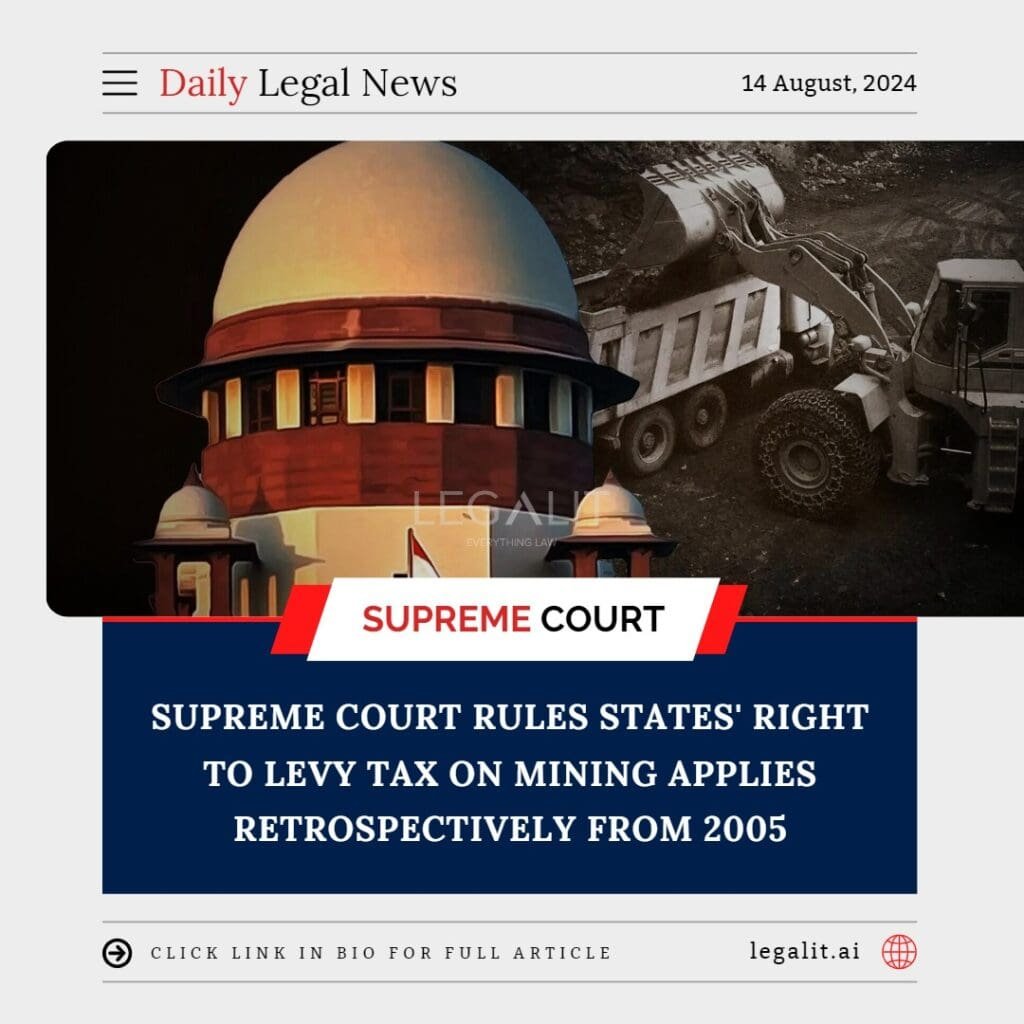
In a landmark judgment, the Supreme Court of India has ruled that states’ right to levy taxes on mining activities will apply retrospectively from 2005. This decision has significant implications for the mining industry and the revenue collected by state governments, as it clarifies the legal framework governing the taxation of mining activities over the past two decades.
Background of the Case
The legal dispute centered around whether states have the authority to impose taxes on mining activities, and if so, whether this authority could be applied retrospectively. The case arose from challenges by various mining companies and associations who argued that states had overstepped their powers by imposing taxes retrospectively, potentially leading to substantial backdated tax liabilities.
Historically, the power to tax mining activities has been a contentious issue, with disputes over the division of taxation powers between the central and state governments. The case ultimately reached the Supreme Court to resolve these disputes and provide clarity on the matter.
Supreme Court’s Ruling
- Retrospective Application from 2005: The Supreme Court ruled that states do have the right to levy taxes on mining activities, and this right applies retrospectively from 2005. This means that any taxes imposed by states on mining operations dating back to 2005 are legally valid.
- Clarification of Taxation Powers: The Court clarified that the authority to levy such taxes falls within the legislative powers of the states under the Constitution of India. This ruling resolves longstanding ambiguities regarding the division of taxation powers related to natural resources like minerals.
- Impact on Mining Companies: The ruling implies that mining companies may now face significant backdated tax liabilities, as states can enforce taxes on mining activities conducted from 2005 onwards. This could result in substantial financial obligations for companies operating in the mining sector.
- Revenue Implications for States: For state governments, the judgment opens the door to potentially significant revenue collections. States can now pursue the collection of back taxes from mining companies, which could provide a substantial boost to their finances.
Implications of the Ruling
The Supreme Court’s decision has several far-reaching implications:
- Financial Impact on Mining Industry: The retrospective application of taxes from 2005 could impose heavy financial burdens on mining companies, leading to increased costs and potential legal challenges. Companies may need to reassess their financial statements and prepare for the possibility of paying substantial back taxes.
- Revenue Windfall for States: State governments stand to gain significantly from this ruling, as they can now collect taxes on mining activities conducted over the past 18 years. This could provide a much-needed revenue boost for states, particularly those with significant mining activities.
- Legal Precedent: The ruling sets an important legal precedent regarding the taxation powers of states, particularly in sectors involving natural resources. It reaffirms the states’ authority to levy taxes and clarifies the retrospective application of such taxes.
- Potential for Further Litigation: The decision may lead to further legal disputes, particularly as mining companies may challenge the assessment and collection of retrospective taxes. There could also be challenges regarding the calculation of such taxes and the interest or penalties that may apply.
- Impact on Future Legislation: The judgment may influence future legislative actions, with states possibly considering new or amended laws to better regulate and tax mining activities. It could also prompt discussions about revising the tax regime to prevent similar disputes in the future.
Moving Forward
Following the Supreme Court’s ruling, several key actions are likely:
- Tax Assessments: State governments will likely begin or continue assessing taxes on mining activities from 2005 onwards, leading to potential tax demands on mining companies.
- Legal Preparations by Companies: Mining companies will need to prepare for possible tax demands, including revisiting financial records, setting aside funds for potential liabilities, and exploring legal options for challenging or negotiating tax claims.
- Policy Responses: The ruling may prompt both state and central governments to review their policies and regulations regarding the taxation of natural resources, potentially leading to reforms aimed at avoiding future disputes.
- Engagement with Stakeholders: Governments and industry stakeholders may engage in discussions to manage the impact of the ruling, seeking solutions that balance the need for revenue with the economic sustainability of the mining sector.
Conclusion
The Supreme Court’s judgment on the states’ right to levy taxes on mining activities retrospectively from 2005 is a landmark decision with significant implications for both the mining industry and state governments. While it clarifies the legal framework for taxation in this sector, the ruling also raises important challenges and opportunities for all parties involved. As the implications of the judgment unfold, it will be crucial for mining companies and state governments to navigate the new legal and financial landscape carefully, ensuring compliance while addressing any potential disputes that may arise.